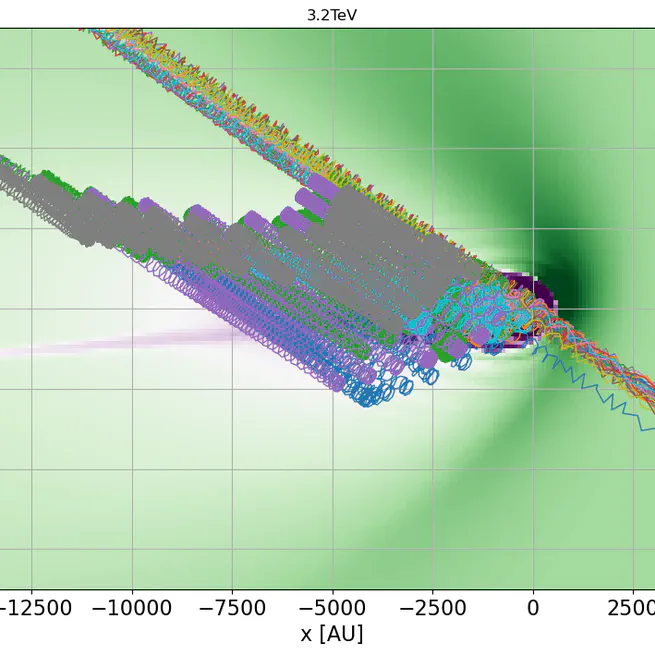
Introduction The propagation of relativistic charged particles in the heliosphere and interstellar magnetic fields is calculated using the ptracing code. This code was originally developed for the studies described in Desiati & Zweibel (2014). It includes several analytical magnetic and electric field configurations and interfaces to different heliospheric numerical models. Additionally, it supports multithreading, allowing it to take full advantage of computers with a large number of CPU cores and shared memory. Trajectories are calculated by numerically integrating the following set of 6–dimensional ordinary differential equations $$\frac{d\mathbf{p}}{dt} = q \left(\mathbf{v}\times\mathbf{B} \right), \, \frac{d\mathbf{r}}{dt} = \mathbf{v},$$ describing the Lorentz force exerted by the magnetic field $\mathbf{B}(\mathbf{r})$ on particles with electric charge $q$ and velocity $\mathbf{v}$, where $\mathbf{r}$ is their position vector and $\mathbf{p}$ the momentum. Momentum is expressed in units of $mc$; $\hat{\mathbf{p}}\equiv\mathbf{p}/mc$. The particle velocity $\mathbf{v}$ is related to $\hat{\mathbf{p}}$ by $\mathbf{v} = \hat{\mathbf{p}}/\sqrt{1+\hat p^2}$ and the particle Lorentz factor $\gamma = \sqrt{1+\hat p^2}$. In these units, the dimensionless particle gyroradius is $\hat r_g = \hat p_{\perp}$, and the dimensionless gyro-frequency is $\hat \omega_g = 1/\gamma$. %We denote normalized variables with a hat. The equations of motion can be numerically integrated using various stepping algorithms. The code supports an adaptive time step size in these calculations, with a tolerance level denoted by a parameter $\epsilon$ to ensure that truncation errors remain sufficiently small. The integration of particle trajectories concludes when either the maximum integration time, $t_\mathrm{max}$, is reached or when the particles have attained a radius of $r_\mathrm{max}$. The figure demonstrates how protons are affected by the heliosphere and the modified magnetic field near its boundary. One challenge in calculating trajectories within open boundary systems is that particles propagating from outside the heliosphere have a very low probability of reaching Earth or passing near it. To address this, we plan to generate 100 million anti-proton trajectories, propagating backward from Earth to a distance of 50,000 AU from the Sun. We compute the trajectories using the Boris Push stepping method. This algorithm has become a standard for this purpose. Although the Boris algorithm is not symplectic, it does conserve phase space volume, and its energy error is globally bounded, comparable to that of symplectic algorithms. To ensure the accuracy of our results and as part of our validation procedure, we will perform additional checks by varying the integration tolerance parameters and comparing the outcomes with the explicit fourth-order Runge-Kutta method. Additionally, we will conduct cross-validation with limited statistics using third-party tools such as CRPropa. We calculate trajectories using heliospheric models provided by our collaborator, Prof. Nikolai Pogorelov, to investigate the systematic effects of model parameters on our data interpretation. According to Liouville’s Theorem, we can interpret the calculated back-propagated anti-proton trajectories as protons traveling from the ISM to Earth. Experimental biases on the heliospheric contribution to the observed TeV cosmic ray anisotropy A preliminary study utilized numerically computed particle trajectories from a computational heliospheric model to assess the experimental biases introduced by ground-based experiments and their impact on interpretations. We intend to conduct thorough investigations into this experimental dimension of cosmic-ray physics, which will aid in developing the analytical tools needed to explore the origins of cosmic-ray anisotropy and its propagation through the interstellar medium and the heliosphere. The paper examines how the heliosphere acts as a magnetic lens that reshapes the TeV cosmic-ray anisotropy we observe on Earth, complicating efforts to infer the true interstellar distribution. Because ground-based reconstructions are effectively “blind” to the north–south (m=0) spherical-harmonic terms, the vertical component of the dipole is lost, which can bias estimates of the pitch-angle distribution in the local interstellar medium (LISM). Even so, the paper argues that higher-order multipoles preserve enough spatial information to constrain the large-scale structure and its alignment with the local interstellar magnetic field (LIMF). The premise is that if we correctly model the heliospheric imprint and account for observational limitations, we can still recover the underlying LISM anisotropy. The reconstructed map of the 10 TeV combined sample after propagation. The direction of the LIMF is indicated by the X and the corresponding magnetic equator (i.e. the plane perpendicular to the uniform LIMF passing by the Earth) is shown with a solid curve. The inferred direction obtained by fitting a circle to the boundary of large-scale excess and deficit regions (dot-dashed green curve) from the true propagated map is indicated with a green star. The equivalent fit (shown as a dashed red curve) for the reconstructed map is indicated with red square. Using back-propagation through a heliospheric field model across multiple rigidities, we reconstruct Earth-frame sky maps, fit the boundary between excess and deficit to infer the LIMF “magnetic equator,” and estimate the missing north–south dipole component. Remapping the result outside the heliosphere then yields an interstellar dipole whose direction is within about 3° of the true LIMF when that compensation is applied (versus ~14° without it). At ~10 TV rigidity, where particle gyroradii match the LIMF draping scale, the heliospheric effect is strong but does not destroy the overall ordering with the LIMF; the method’s accuracy, however, depends on the chosen heliosphere/LIMF model. The paper highlights the next steps, which include scanning heliotail length, solar-cycle phase, turbulence, and LIMF geometry to quantify model sensitivities. Chaotic Behavior of Trapped Cosmic Rays A recently published paper develops a practical way to quantify how cosmic rays behave chaotically when they’re temporarily trapped by coherent magnetic structures—especially the heliosphere acting as a magnetic mirror. Using an axially symmetric “magnetic bottle” tailored to heliospheric scales (field strengths ~1–3 μG; mirror separation ~2000 au), the authors integrate ensembles of 1 TeV test-particle trajectories and compute finite-time Lyapunov exponents (FTLEs), which measure how rapidly nearby trajectories diverge over a chosen time window. They also add time-dependent perturbations designed to mimic solar-cycle polarity reversals (including a check on induced electric fields) to see how temporal variability alters the chaos. The key diagnostic is the joint behavior of FTLE versus a particle’s escape time from the mirror. The central result is a robust power-law correlation: once particles have reached their most chaotic state, the FTLE scales approximately as the inverse of the escape time (slope ≈ −1), and this relation persists under weak and strong time perturbations. On that basis, trajectories naturally fall into regimes—transient (quick escape, little chaos), intermediate (brief explosive divergence), a broad “power-law” class (regular vs. irregular chaotic orbits with steadily increasing dwell times), and, in the unperturbed case only, long-lived trapped orbits. Mapping FTLE and escape time onto the sky reveals distinct regions and gradients in chaoticity; adding perturbations erases the strictly trapped region and redistributes particles toward shorter escape times, while maintaining the same FTLE–escape-time slope. Because 1–10 TV rigidities have gyroradii comparable to heliospheric scales, the study argues that chaotic mirroring can imprint time variability—on solar-cycle timescales and in specific sky sectors—on observed TeV anisotropy maps, such as those from HAWC+IceCube. The method provides a framework for interpreting such variations and is intended to be applied to more realistic MHD–kinetic heliosphere models and to other magnetic mirrors (e.g., superbubbles), thereby linking microphysical trajectory chaos to macroscopic anisotropy morphology. The Role of the Heliosphere in Shaping the Observed Cosmic Ray Spectral Anisotropy Report on a study of cosmic-ray tracing through the heliosphere to investigate the induced modulations in the energy spectrum of the cosmic rays. The work was presented at the ICRC 2025 Conference in Geneva.
Sep 27, 2025
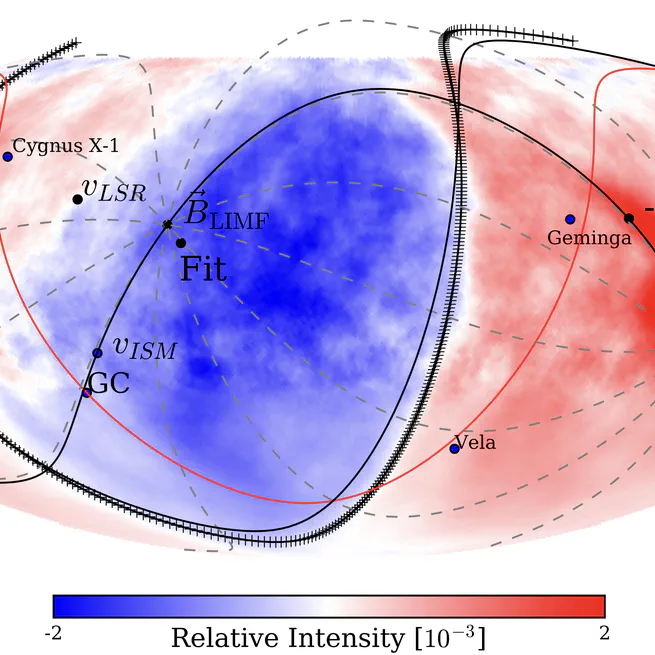
Introduction The IceCube and the HAWC observatories have established themselves as leaders in studying Galactic cosmic-ray anisotropy in the TeV–PeV energy range. IceCube captures anisotropy amplitudes with high precision by mapping cosmic-ray arrival directions relative to an isotropic reference. The IceTop surface array detects showers above 500 TeV, while the deep in-ice array records muons down to 10 TeV, both closely aligning with primary cosmic-ray directions. HAWC gamma-ray array detects showers above 1-10 TeV. IceCube and HAWC’s continuous sky observation enhances measurement stability, enabling energy-dependent anisotropy studies and spherical harmonic expansion analysis. Recent findings highlight the dipole component’s amplitude and phase as indicators of cosmic-ray diffusion in interstellar plasma. The angular power spectrum at different energies reflects pitch angle scattering processes. IceCube has submitted results from 12 years (2011–2023) of cosmic-ray muon data, refining event selection for improved stability. High-resolution sky maps will explore temporal anisotropy variations and cross-check muon and shower data consistency. IceCube also analyzes the Compton-Getting effect for calibration and cosmic-ray spectral index measurement. Given individual experiments’ limited sky coverage, full-sky measurements via collaborations with HAWC, GRAPES-3, TALE, and KASCADE aim to provide a comprehensive view of anisotropy. These efforts will improve understanding of cosmic-ray diffusion and heliospheric influence on observed distributions. Publications This is the list of cosmic-ray anisotropy results published by the team: citation title DOI arXiv ApJ (2010) 718 L194 Measurement of the Anisotropy of Cosmic Ray Arrival Directions with IceCube 10.1088/2041-8205/718/2/L194 1005.2960 ApJ (2011) 740 16 Observation of Anisotropy in the Arrival Directions of Galactic Cosmic Rays at Multiple Angular Scales with IceCube 10.1088/0004-637X/740/1/16 1105.2326 ApJ (2012) 746 33 Observation of an Anisotropy in the Galactic Cosmic Ray arrival direction at 400 TeV with IceCube 10.1088/0004-637X/746/1/33 1109.1017 ApJ (2013) 765 55 Observation of Cosmic Ray Anisotropy with the IceTop Air Shower Array 10.1088/0004-637X/765/1/55 1210.5278 ApJ (2016) 826 220 Anisotropy in Cosmic-Ray Arrival Directions in the Southern Hemisphere with Six Years of Data from the IceCube Detector 10.3847/0004-637X/826/2/220 1603.01227 ApJ (2019) 871 96 All-Sky Measurement of the Anisotropy of Cosmic Rays at 10 TeV and Mapping of the Local Interstellar Magnetic Field 10.3847/1538-4357/aaf5cc 1812.05682 ApJ (2025) 981 182 Observation of Cosmic-Ray Anisotropy in the Southern Hemisphere with 12 yr of Data Collected by the IceCube Neutrino Observatory 10.3847/1538-4357/adb1de 2412.05046 Observation of Cosmic-Ray Anisotropy in the Southern Hemisphere with 12 yr of Data Collected by the IceCube Neutrino Observatory In our latest IceCube publication, we report a definitive, high-statistics view of TeV–PeV cosmic-ray anisotropy in the Southern Hemisphere using 7.92×10¹¹ cosmic-ray–induced muon events collected by the fully built detector between May 13, 2011 and May 12, 2023. With improved simulations and uniform, year-by-year processing, systematic uncertainties are reduced to levels below statistical fluctuations. The data confirm the long-noted evolution of the anisotropy’s angular structure between ~10 TeV and 1 PeV—most prominently across 100–300 TeV—and, for the first time in IceCube, present energy-dependent angular power spectra that show comparatively diminished large-scale power at the highest energies while retaining significant medium/small-scale structure down to ~6°. Methodologically, the analysis builds reference maps via 24-hour time-scrambling and quantifies relative intensity per sky pixel, with top-hat smoothing (typically 20°; 5° for certain low-energy residual maps) used only for visualization; the median angular resolution is ~3° and reaches ~1° above 100 TeV. Systematics from the interference between sidereal anisotropy and the solar Compton–Getting effect are controlled by analyzing full calendar years and by checking the antisidereal frame; the resulting systematic spreads are now comparable to statistical errors—a marked improvement over earlier IceCube work. Angular pseudo-power for selected spherical harmonic modes (ℓ) as a function of median primary energy for 12 yr of IceCube data. Errors bars are statistical. The bands indicate the 95% spread in C˜ℓ from a large sample of scrambled maps. The color of the bands corresponds to that of the data symbols but in a lighter shade. Physically, the horizontal (equatorial) dipole component behaves as in other experiments: its amplitude decreases from ~10 TeV to just above 100 TeV—reaching a minimum of ≈2×10⁻⁴ while its phase flips from ~RA 50° to ~RA 260°—then rises again with energy. At ~5.3 PeV, the dipole is only marginally distinguishable from isotropy, yielding a 99%-CL upper limit of 3.34×10⁻³. The measured dipole phase and amplitude align with Northern-hemisphere results once field-of-view biases in one-dimensional fits are corrected, reinforcing a coherent, largely horizontal large-scale pattern across both hemispheres. IceCube’s event selection and reconstruction underpin these results: the detector triggers at 2.0–2.3 kHz on muon bundles that track the parent cosmic-ray directions to within a few degrees, and a compact “DST” data stream preserves the essential kinematics for anisotropy analyses over the full 12-year exposure. Residual maps—after subtracting dipole and quadrupole—reveal persistent smaller-scale structure at both low (<18 TeV) and high (>320 TeV) energies. Together, these advances deliver the most precise Southern-sky anisotropy maps to date and a clean baseline for future joint, full-sky studies that probe how the anisotropy’s scale mix evolves with energy. Time Variation in the TeV Cosmic Ray Anisotropy with IceCube and Energy Dependence of the Solar Dipole Report on the analyses of the time variations in the cosmic-ray anisotropy and preliminary results on the measurement of the orbital Compton-Getting Effect observed by IceCube, presented at the ICRC 2025 Conference in Geneva. NSF award #2209483. Investigating Energy-Dependent Anisotropy in Cosmic Rays with IceTop Surface Array Report on the analysis of the cosmic-ray anisotropy measured by the IceTop surface array, presented at the ICRC 2025 Conference in Geneva. NSF award #2209483. All-Sky Cosmic-Ray Anisotropy Update at Multiple Energies Results on the combined analysis of cosmic-ray anisotropy with the HAWC observatory and with HAWC and IceCube observatories and the demonstration of rigidity scaling, presented at the ICRC 2025 Conference in Geneva. NSF award #2310092.
Sep 27, 2025

The Southern Wide-field Gamma-ray Observatory (SWGO) is an astrophysics project in the southern hemisphere. The scientific potential of a wide field of view and very high-duty cycle ground-based gamma-ray detectors has been demonstrated by the current generation instruments HAWC and ARGO, and this potential will be extended in the Northern Hemisphere by LHAASO. No such instrument currently exists in the Southern Hemisphere, where there is significant potential for mapping large-scale emissions and providing access to the entire sky for transient and variable multi-wavelength and multi-messenger phenomena. Access to the Galactic Center, in conjunction with the major facility CTA-South, motivates the establishment of such a gamma-ray observatory in the south. Additionally, there is substantial potential for cosmic ray studies, including anisotropy. The shared concept for the future observatory is as follows: A gamma-ray observatory based on ground-level particle detection, with close to 100% duty cycle and order steradian field of view. Located in Atacama Astronomical Park, Chile. At an altitude of 4770 m. Covering an energy range from 100s of GeV to the PeV scale. Based primarily on water Cherenkov detector units. With a high fill-factor core detector with an area considerably larger than HAWC and significantly better sensitivity, and a low-density outer array.
Feb 1, 2025
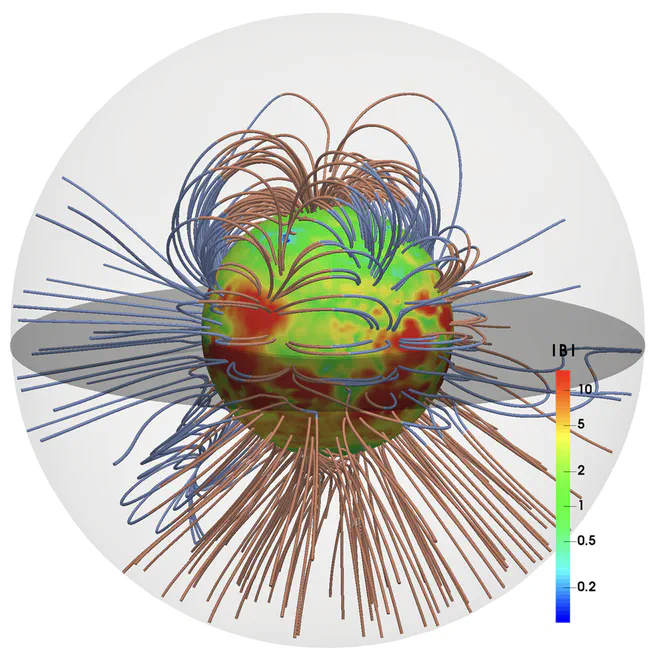
Introduction Observations of the time-dependent cosmic-ray Sun shadow have proven to be a valuable diagnostic tool for assessing solar magnetic field models. This project compares several years of IceCube data with solar activity and solar magnetic field models. For the first time, a quantitative comparison of solar magnetic field models with IceCube data at the event rate level is conducted. Additionally, we present an initial energy-dependent analysis compared to recent predictions. We utilize seven years of IceCube data for the moon and the Sun, comparing them with simulations at the data rate level. The simulations are performed under the geometrical shadow hypothesis for both the moon and the Sun and under a cosmic-ray propagation model influenced by the solar magnetic field for the Sun case. Our findings indicate a linearly decreasing relationship between Sun shadow strength and solar activity, which is preferred over a constant relationship at the 6.4σ level. We evaluate two commonly used coronal magnetic field models, both in conjunction with a Parker spiral, by modeling cosmic-ray propagation in the solar magnetic field. Both models predict a weakening of the shadow during periods of high solar activity, which is also observable in the data. We observe tensions with the data on the order of 3σ for both models, assuming only statistical uncertainties. The magnetic field model CSSS fits the data slightly better than the PFSS model. This finding generally aligns with earlier results from the Tibet AS-γ Experiment; however, the deviation of the data from the two models is not significant at this time. Regarding the energy dependence of the sun shadow, we find indications that the shadowing effect increases with energy during periods of high solar activity, which is consistent with theoretical predictions. In contrast, the Sun’s shadow varies seasonally, with IceCube detecting a significant deviation from the mean Sun shadow (χ²/ndof = 22.47/4, 3.8σ). This variation is likely linked to the Sun’s magnetic field changes, consistent with past Tibet observations at lower energies. A Spearman’s rank test suggests a 96% likelihood of correlation between sunspot number and the Sun shadow’s amplitude. However, further data are needed to confirm this relationship, given the limited observation periods and a weak solar cycle. Future studies should refine models of cosmic ray deflection by solar magnetic fields and improve point spread function treatments to enhance comparisons between observational data and simulations. Publication of IceCube research The investigations on the Sun’s cosmic-ray shadow’s time variabilities were published in The Astrophysical Journal. A more detailed study was published in Physical Review D where the Sun shadow’s time variability is associated with solar cycles, as opposed to the constant Moon cosmic-ray shadow, whose slow variability with time is only associated to the change in average Moon-Earth’s distance. Publication of numerical calculations The latest observational result was paired with a dedicated study of cosmic-ray particle trajectories propagating near the Sun, assuming different models of the solar corona’s magnetic field and its variability across the solar cycles. The report was published in Astronomy & Astrophysics.
Feb 1, 2025
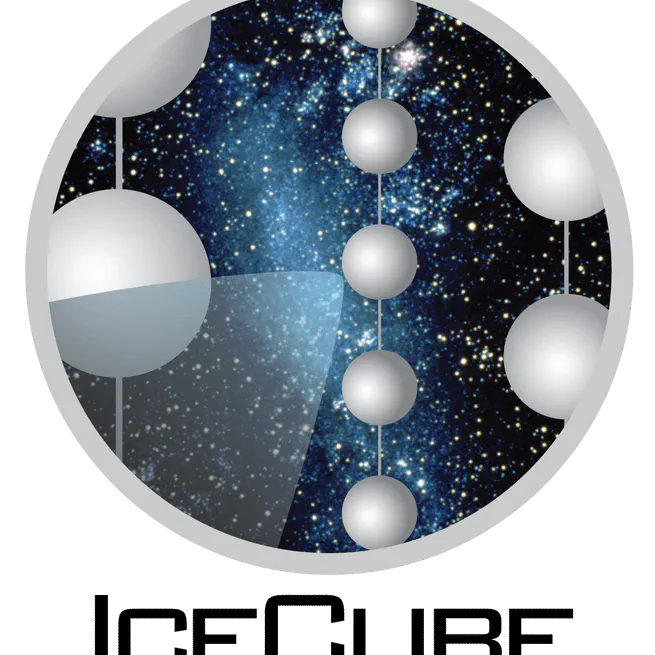
IceCube Neutrino Observatory is an astrophysics project located at the geographic South Pole. The IceCube Neutrino Observatory is the first detector of its kind, designed to observe the cosmos from deep within the South Pole ice. The IceCube Collaboration is an international group of scientists responsible for scientific research. Encompassing a cubic kilometer of ice, IceCube searches for nearly massless subatomic particles called neutrinos. These high-energy astronomical messengers provide information to probe the most violent astrophysical sources, such as exploding stars, gamma-ray bursts, and cataclysmic phenomena involving black holes and neutron stars. The Antarctic Neutrino Observatory, including the surface array IceTop and the dense infill array DeepCore, was designed as a multipurpose experiment. IceCube collaborators address several big questions in physics, like the nature of dark matter and the properties of the neutrino itself. IceCube also observes cosmic rays that interact with the Earth’s atmosphere, which have revealed fascinating structures that are not presently understood. The IceCube Collaboration comprises approximately 350 physicists from 58 institutions in 14 countries. The international team is responsible for the scientific program, and many collaborators contributed to the design and construction of the detector. Exciting new research conducted by the collaboration is opening a new window for exploring our universe. The National Science Foundation (NSF) provided the primary funding for the IceCube Neutrino Observatory, with assistance from partner funding agencies around the world. The University of Wisconsin–Madison is the lead institution responsible for maintaining and operating the detector. Funding Agencies in each collaborating country support their scientific research efforts.
Feb 1, 2025

The High Altitude Water Cherenkov (HAWC) is an astrophysics project located in Mexico. HAWC is a facility designed to observe gamma rays and cosmic rays between 100 GeV and 100 TeV. TeV gamma rays are the highest energy photons ever observed — 1 TeV is 1 trillion electron volts (eV), about 1 trillion times more energetic than visible light! These photons are born in the most extreme environments in the known universe: supernova explosions, active galactic nuclei, and gamma-ray bursts. Cosmic rays are charged particles that achieve energies far beyond what we can create in man-made particle accelerators. (The highest energy cosmic ray ever observed was 300 million TeV.) The origin of such particles has been a mystery for over 100 years. Gamma rays are thought to be correlated with the acceleration sites of charged cosmic rays, so we observe them to help answer this and other cosmic questions. HAWC is located on the flanks of the Sierra Negra volcano near Puebla, Mexico, at an altitude of 4100 meters (13,500 feet). The detector has an instantaneous field of view covering 15% of the sky, and during each 24 hours, HAWC observes two-thirds of the sky. Using the HAWC Observatory, we are performing a high-sensitivity synoptic survey of the gamma rays from the Northern Hemisphere.
Feb 1, 2025
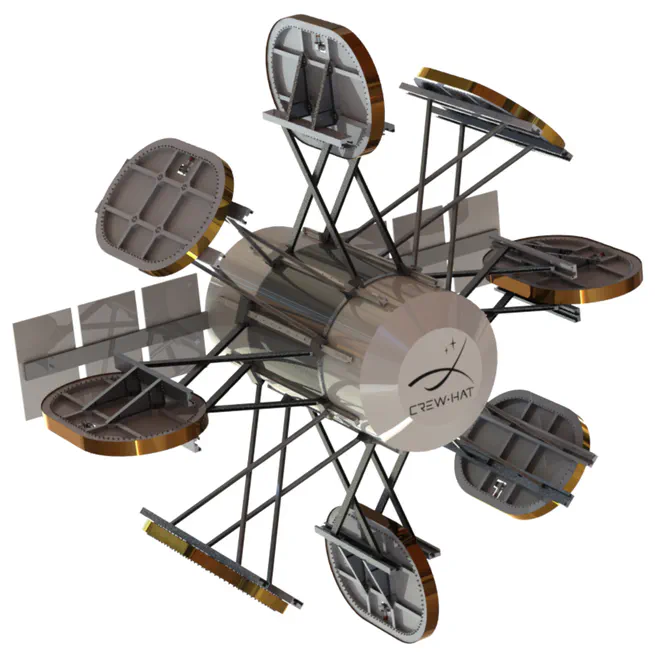
CREW-HaT stands for Cosmic Radiation Extended Warding using the Halbach Torus. NIAC Phase I 2022 The CREW-HaT project was awarded the NASA Innovative Advanced Concepts - NIAC Phase I award in 2022. The 21st century will be when human space exploration gets off the ground. NASA’s priority is to send humans back to the Moon in the next decade with the Artemis mission and travel to Mars in the following decade. In parallel, SpaceX and Blue Origin companies are developing the technology to make human access to space routine. However, achieving this goal is only possible if we can protect the humans we send to space from the damaging effects of cosmic rays and energetic solar radiation. The health risks to astronauts associated with chronic exposure to radiation in space include carcinogenesis, cardiovascular damage, and degradation of the central nervous system. Since the Earth’s magnetic field is responsible for protecting us on Earth’s surface, a logical solution to the problem would be to have a spacecraft bring along its equivalent magnetic field. Here, we propose CREW HaT, a new concept for a Halbach Torus (HaT), which consists of light, deployable, mechanically supported magnetic coils activated by a new generation of high-temperature superconducting tapes that have recently become available. This configuration produces an enhanced external magnetic field that diverts cosmic radiation particles, complemented by a suppressed magnetic field in the astronaut’s habitat. The Halbach torus geometry has never been explored in this context or studied in combination with modern superconductive tapes. It diverts over 50% of the biology-damaging cosmic rays (protons below 1 GeV) and higher energy high-Z ions. This is sufficient to reduce the radiation dose absorbed by astronauts to a level of <5% of the lifetime excess risk of cancer mortality levels established by NASA. Paper The concept was presented at the 51st International Conference on Environmental Systems (ICES) in Saint Paul, MN, in July 2022. Innovation NASA has announced future human space expeditions (the Artemis mission in the next decade and the Mars mission within the next decade). These expeditions will only be possible if we efficiently mitigate the effects of harmful cosmic radiation on astronauts. Using a lightweight and non-cost-prohibitive structure, one feasible solution is to surround the spacecraft with protective magnetic fields that divert cosmic radiation. The CREW HaT consists of a Halbach Torus (HaT), a novel arrangement comprising spatially rotating coils around the spacecraft. This configuration produces an enhanced external magnetic field (open magnetic field) to divert cosmic radiation particles, complemented by a reduced magnetic field in the astronauts’ habitat. CREW HaT is likely to be the most feasible solution for active shielding, which this proposal intends to demonstrate. The CREW HaT is a deployable device integrated with the spacecraft. It unfolds and generates a magnetic field that deflects cosmic radiation from solar wind particles and galactic cosmic rays. Recent innovations in high-temperature superconductors (e.g., ReBCO) enable the necessary high currents. Our innovation benefited from the support provided to us by the UW-Madison’s Discovery to Product. Potential & Benefits The CREW-HaT is superior to the existing benchmark active shielding technology previously proposed (MAARSS Soleinoidal Coil system by Westover et al., NIAC 2012). It dramatically reduces the health risk for astronauts because: It diverts over 50% of the biology-damaging cosmic rays (protons below 1 GeV) and higher energy high-Z ions. This is sufficient to reduce the radiation dose absorbed by astronauts to a level of <5% of the lifetime excess risk of cancer mortality levels established by NASA. It has an over 80% smaller support structure volume, thus reducing secondary radiation, X-rays, gamma-rays, and neutrons produced by cosmic rays impacting spacecraft. Previous magnetic topologies (e.g., the MAARSS system) did not fully address this problem. It suppresses the magnetic field in the astronauts’ habitat without the need for an additional compensation coil. This increases crew safety and prolongs the lifetime of the instrumentation without increasing weight and power consumption. This innovative concept provides the aerospace community with a solution to protect humans and instrumentation on satellites exposed to space radiation from catastrophic solar flares and cosmic ray particles. It can protect any spacecraft or surface installation on, for example, the Moon while making it possible for long-duration space trips to Mars.
Feb 1, 2025